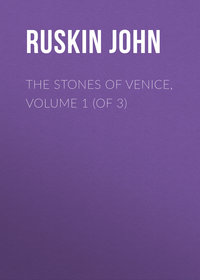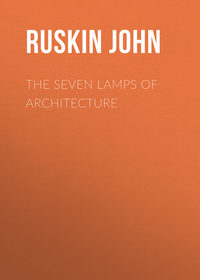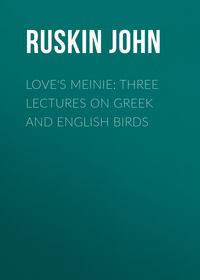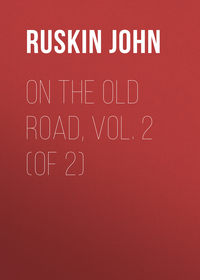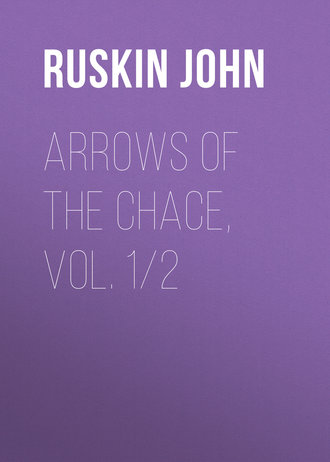 полная версия
полная версияArrows of the Chace, vol. 1/2
176
See “Modern Painters,” Part v., chap. 13, “On the Sculpture Mountains,” vol. iv. p. 174.
177
In connection with the question of glacier-motion, Mr. Ruskin’s estimate of Professor Forbes and his work is here reprinted from Rendu’s “Glaciers of Savoy” (Macmillan, 1874), pp. 205-207. For a passage on the same subject which was reprinted in the “Glaciers of Savoy,” in addition to the new matter republished here, and for a statement of the course of glacier-science, and the relation of Forbes to Agassiz, the reader is referred to “Fors Clavigera,” 1873, Letter 34, pp. 17-26. The “incidental passage” consists of a review of Professor Tyndall’s “Forms of Water” (London, 1872), and the “contemptible issue” was that of his position and Forbes’ amongst geological discoverers.
178
George Forbes, B.A., Professor of Natural Philosophy in the Andersonian University, Glasgow, and editor of “The Glaciers of Savoy.”
179
This saying of Macaulay’s occurred in an address which, as M.P. for that city, he delivered at the opening of the Edinburgh Philosophical Institution, 1846 (Nov. 4). Forbes’ criticism of it and of the whole address may be found in a lecture introductory to a course on Natural Philosophy, delivered before the University of Edinburgh (Nov. 1 and 2, 1848), and entitled “The Danger of Superficial Knowledge;” under which title it was afterwards printed, together with a newspaper report of Macaulay’s address (London and Edinburgh, 1849). In the edition of Macaulay’s speeches revised by himself, the sentence in question is omitted, though others of a like nature, such as “The profundity of one age is the shallowness of the next,” are retained, and the whole argument of the address remains the same. (See Macaulay’s Works, 8 vol. ed., Longmans, 1866. Vol. viii. p. 380, “The Literature of Great Britain.”) For a second mention of this saying by Mr. Ruskin, see also “Remarks addressed to the Mansfield Art Night Class,” 1873, now reprinted in “A Joy for Ever” (Ruskin’s Works, vol. xi. p. 201).
The following are parts of the passage (extending over some pages) in Forbes’ lecture alluded to by Mr. Ruskin:
“How false, then, as well as arrogant, is the self-gratulation of those, who, forgetful of the struggles and painful efforts by which knowledge is increased, would place themselves, by virtue of their borrowed acquirements, in the same elevated position with their great teachers—nay, who, perceiving the dimness of light and feebleness of grasp, with which, often at first, great truths have been perceived and held, find food for pride in the superior clearness of their vision and tenacity of their apprehension!” Then, after quoting some words from Dr. Whewell’s “Philosophy of the Inductive Sciences,” vol. ii. p. 525, and after some further remarks, the lecturer thus continued: “The activity of mind, the earnestness, the struggle after truth, the hopeless perplexity breaking up gradually into the fulness of perfect apprehension,—the dread of error, the victory over the imagination in discarding hypotheses, the sense of weakness and humility arising from repeated disappointments, the yearnings after a fuller revelation, and the sure conviction which attends the final advent of knowledge sought amidst difficulties and disappointments,—these are the lessons and the rewards of the discoverers who first put truth within our reach, but of which we who receive it at second hand can form but a faint and lifeless conception.” (See pp. 39-41 of “The Danger of Superficial Knowledge.”)
180
In the edition of Rendu’s “Glaciers of Savoy” already alluded to.
181
Forbes died Dec. 31, 1868; Agassiz in 1873; and De Saussure in 1845.
182
The letter from Forbes to Mr. Ruskin (dated December 2, 1864) was presumably elicited by the allusions to Forbes in Mr. Ruskin’s letter to the Reader of November 26, 1874 (see ante, pp. 259 and 263). “Advancing years and permanently depressed state of health,” ran the letter, “have taken the edge off the bitterness which the injustice I have experienced caused me during many years. But … the old fire revives within me when I see any one willing and courageous, like you, to remember an old friend, and to show that you do so.”—The second letter speaks of the writer’s “boyish enthusiasm” for Agassiz, an expression to which Mr. Ruskin appends this note: “The italics are mine. I think this incidental and naïve proof of the way in which Forbes had spoken of Agassiz to his class, of the greatest value and beautiful interest.—J. R.”
183
In the first edition of “Modern Painters” (vol. i. p. 330) it was stated that “the horizontal lines cast by clouds upon the sea are not shadows, but reflections;” and that “on clear water near the eye there can never be even the appearance of shadow.” This statement being questioned in a letter to the Art Union Journal (November, 1843), and that letter being itself criticised in a review of “Modern Painters” in the Artist and Amateur’s Magazine, p. 262 (December, 1843), there appeared in the last-named periodical two letters upon the subject, of which one was from J. H. Maw, the correspondent of the Art Union, and the other—that reprinted here—a reply from “The Author of ‘Modern Painters.’ ”
184
The passages in “Modern Painters” referred to in this letter were considerably altered and enlarged in later editions of the work, and the exact words quoted are not to be found in it as finally revised. The reader is, however, referred to vol. i., part ii., § v., chap. i., “Of Water as painted by the Ancients,” in whatever edition of the book he may chance to meet with or possess.
185
See the Artist and Amateur’s Magazine, p. 313, where the author of the letter, to which this is a reply, adduced in support of his views the following experiment, viz.: to put a tub filled with clear water in the sunlight, and then taking an opaque screen with a hole cut in it, to place the same in such a position as to intercept the light falling upon the tub. Then, he argued, cover the hole over, and the tub will be in shadow; uncover it again, and a patch of light will fall on the water, proving that water is not “insusceptible of light as well as shadow.”
186
In the review of “Modern Painters” mentioned above.
187
Of the first edition of the first volume of “Modern Painters.” The size of the book (and consequently the paging) was afterwards altered to suit the engravings contained in the last three volumes.
188
It may be worth noting that the optical delusion above explained is described at some length by Mr. Herbert Spencer (“The Study of Sociology,” p. 191, London, 1874) as one of the commonest instances of popular ignorance.
189
Of course, if water be perfectly foul, like that of the Rhine or Arve, it receives a shadow nearly as well as mud. Yet the succeeding observations on its reflective power are applicable to it, even in this state.
190
It must always be remembered that there are two kinds of reflection,—one from polished bodies, giving back rays of light unaltered; the other from unpolished bodies, giving back rays of light altered. By the one reflection we see the images of other objects on the surface of the reflecting object; by the other we are made aware of that surface itself. The difference between these two kinds of reflection has not been well worked by writers on optics; but the great distinction between them is, that the rough body reflects most rays when the angle at which the rays impinge is largest, and the polished body when the angle is smallest. It is the reflection from polished bodies exclusively which I usually indicate by the term; and that from rough bodies I commonly distinguish as “positive light;” but as I have here used the term in its general sense, the explanation of the distinction becomes necessary. All light and shade on matter is caused by reflection of some kind; and the distinction made throughout this paper between reflected and positive light, and between real and pseudo shadow, is nothing more than the distinction between two kinds of reflection.
I believe some of Bouguer’s [Pierre Bouguer, author of, amongst other works, the “Traité d’Optique sur la Gradation de la Lumière.” He was born in 1698, and died in 1758] experiments have been rendered inaccurate—not in their general result, nor in ratio of quantities, but in the quantities themselves—by the difficulty of distinguishing between the two kinds of reflected rays.
191
The mercury must of course be perfectly clean.
192
Among other points, I have not explained why water, though it has no shadow, has a dark side. The cause of this is the Newtonian law noticed below, that water weakens the rays passing through its mass, though it reflects none; and also, that it reflects rays from both surfaces.
193
The review of “Modern Painters” had mentioned the Grotto of Capri, near Naples, as “a very beautiful illustration of the great quantity of light admitted or contained in water,” and on this Mr. J. H. Maw had commented.
194
The London Review of May 4 contained a critique of the Exhibition of the Society of Water-colors, which included a notice of Mr. Duncan’s “Shiplake, on the Thames” (No. 52). In this picture the artist had painted a rainbow reflected in the water, the truth of which to nature was questioned by some of his critics. Mr. Ruskin’s was not the only letter in support of the picture’s truth.
195
The present letter is the earliest in date of any in these volumes.
196
See note to p. 182.
197
In the “Notes on the Turner Gallery at Marlborough House,” 1856 (p. 23), Mr. Ruskin speaks of the “pale ineffable azure” of the gentian. The present letter was written in reply to one signed “Y. L. Y.” in the Athenæum of February 7, 1857, in which this expression was criticised. In a subsequent issue of the same journal (February 21) Mr. Ruskin’s querist denied the ignorance imputed to him, and still questioned the propriety of calling the gentian “pale,” without at the same time distinguishing the two species.




